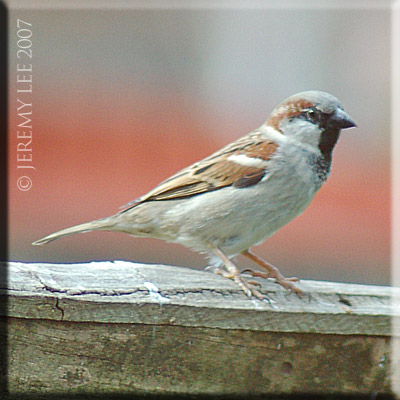
 |
|
Scientific Classifications explained » Amphibians » Ants » Aphids » Bees » Beetles » Birds » Bugs » Butterflies » Caterpillars » Damselflies » Dragonflies » Earwigs » Flies » Frog/Leafhoppers » Fungi » Galls » Grasshoppers » Harvestmen » Hoverflies » Lacewings » Ladybirds » Leaf Mines » Lichens » Mammals » Millipedes » Mosses » Moths » Sawflies » Slugs » Snails » Spiders » Trees & Shrubs » Wasps » Wild Flowers » Woodlice » Postboxes |
UK Nature > Birds > Passer domesticus

Scientific Name: Passer domesticus Common Name: House Sparrow Passer domesticus, more commonly known as the House Sparrow, is approximately 15cm in length with streaked brown back and wings and a stout bill in both sexes. The male (pictured above) is discernable by his grey crown and black eyes and bib. The female has a brown crown, no bib, but has a lighter coloured head stripe running from front to back across the eyes. Eats mainly seeds, insects and spiders, but will eat almost anything on the bird table in winter. Gregarious at all times. Their nest, usually wedged into a hole or on a building ledge, often amongst ivy and other creepers, is an untidy mass of grass and straw, often with paper and string, and lined with hair and feathers. Sometimes they are built in a hedge, and these are usually a neater, domed structure. Found in parks, gardens and neighbouring fields and hedgerows; rarely far from human habitation. Present throughout the UK but suffered a decline through the 1990's, although seems to be making a strong recovery. |
|

https://www.uknature.co.uk is a website dedicated to showing the immense diversity of UK nature and wildlife. Our vast range of habitats, from lowland arable to snow covered mountains, from storm-ravaged coastlines to peaceful inland freshwater lakes and rivers, from dry, sandy heaths to deciduous and coniferous forests, all these habitats contribute to the abundance of UK nature. We have wild birds in huge numbers either residing or visiting our shores (597 recorded species as at July 2013) and we must also not forget the humble back garden with its grass lawns, flower beds filled with nectar rich flowers, shrubs and trees, all designed to attract huge numbers of insects such as bees, moths, butterflies and hoverflies; and finally the small ponds which provide safe havens for frogs, toads, newts and even slow worms and grass snakes. www.uknature.co.uk is the showcase for my personal passion, photographing uknature in all its glory. I sincerely hope you all enjoy the fruits of my labours. This site and all images contained therein is © Jeremy Lee 2004 - 2025. All Rights Reserved. Site design by Jeremy Lee. Site development & IT Support by Stuart Lee. |